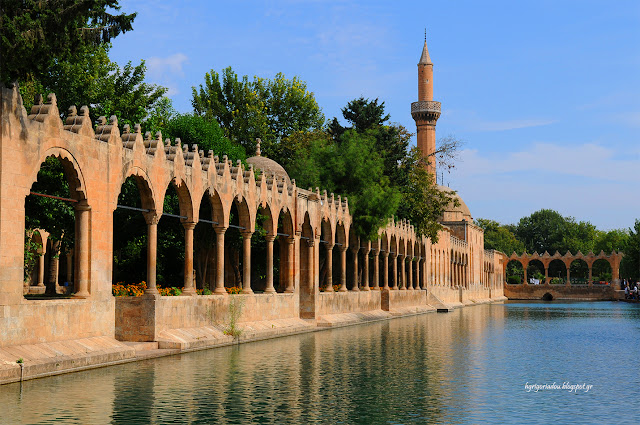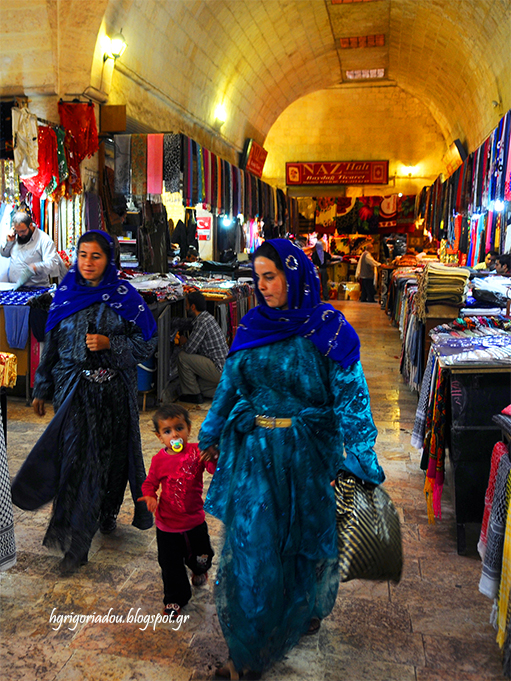One of
Turkey’s most historic civilization, is considered the forth religious city after Mecca,
Medina and Jerusalem, known as Edessa in
ancient times was famous for its artists, musicians, writers, poets and
handicrafts men.
Is located in the southeast of Turkey, at the center of the GAP (Southeastern Anatolia project, a large scale-damming and irrigation program undertaken by the Turkish government).
As it is one of the oldest settlement in Mesopotamia, and due to its strategical location close to the water sources (just eighty km. east of the Euphrates River) and crossroad of trade, always has had a great importance throughout the history.
For Muslims is most famous as is supposed birthplace of the biblical patriarch Abraham, who is the father of Judaism, Christianity and Islam. A half-dozen mosques crowd around the cave where Muslims believe Abraham was born, and a poll near the cave is filled with what are believed to be sacred carp.
Is located in the southeast of Turkey, at the center of the GAP (Southeastern Anatolia project, a large scale-damming and irrigation program undertaken by the Turkish government).
As it is one of the oldest settlement in Mesopotamia, and due to its strategical location close to the water sources (just eighty km. east of the Euphrates River) and crossroad of trade, always has had a great importance throughout the history.
For Muslims is most famous as is supposed birthplace of the biblical patriarch Abraham, who is the father of Judaism, Christianity and Islam. A half-dozen mosques crowd around the cave where Muslims believe Abraham was born, and a poll near the cave is filled with what are believed to be sacred carp.
Pre-Pottery Neolithic Era, a stage of prehistoriry some 13.000 years ago when humankind was making the first steps toward settlement and agriculture.In Sanliurfa Archeology Museum you can see what is arguably the world’s oldest statue and at the nearby Gobekli Tepe you can see the oldest monumental construction.This Holy city is full of historic religious, public and civil architectural buildings. It is important not only for hosting the early civilizations but is the place where the first Islamic University is founded. Sanliurfa , often simply known as Urfa in daily language, is a city with a mixed Kurdish, Turkish an Arab population.This has gained a reputation as a focus for Islamic fundamentalism. Today is the closest Turkish city to Kobani, a meeting point for Syrians who fled the onslaught from ISIS fighters and Kurdish activists trying to help the embattled Syrian Kurdish militiamen defending the town.Just as compelling is the town’s Middle Eastern atmosphere, with golden-color stone houses, religious shrines filled with visiting pilgrims, and an authentic bazaar displaying mounds and mounds of the local specialty-crushed red pepper, in various shades and levels of spices.

Its chief attraction is a beautiful mosque complex, reflected in the limpid waters of a sacred pool (Balikli Gol) which believed to be the place where Nimrod threw Abraham into the fire. God changed the flames into water and the wood into fish to protect Abraham.
The ruins of a Macedonian fortress, above the series of pool is one of the most inviting sights in Turkey, surrounded by acres devoted to open grassy areas and shandy tea gardens. You can see mosques and minarets dating back 600 years to the Selcuks, along with late Ottoman architecture. Modern and ancient by turns, the town has a holy site and the most authentic bazaar in Turkey.
Sanliurfa’s bazaar was an important center for shopping in older times.
People used to look for a social place that they could hang around in during the summer. The most important of the bazaars is the Benesten market, which was built in 1562.
The large market is located near Gumruk Han and the Rizman Ahmet Pasa Vakfiye, which was built in 1740. The locals refer to the mall as "Bezzazistan".

Percheived as one of the best examples of ancient Turkish bazaars in Anatolia that have remained true to their historical identity and retained their original architecture.
Harran:The city of the Holy Bible.
Harran:The city of the Holy Bible.
The most distinctive aspect of Harran is its mud beehive houses, and you can visit models of these at the Harran Kultur Evi (Cultural center).
Sanliurfa is one of the most serene, inviting place I’ve ever passed the days but keep in mind that the town plainly is not every traveler’s cap of tea!!!













